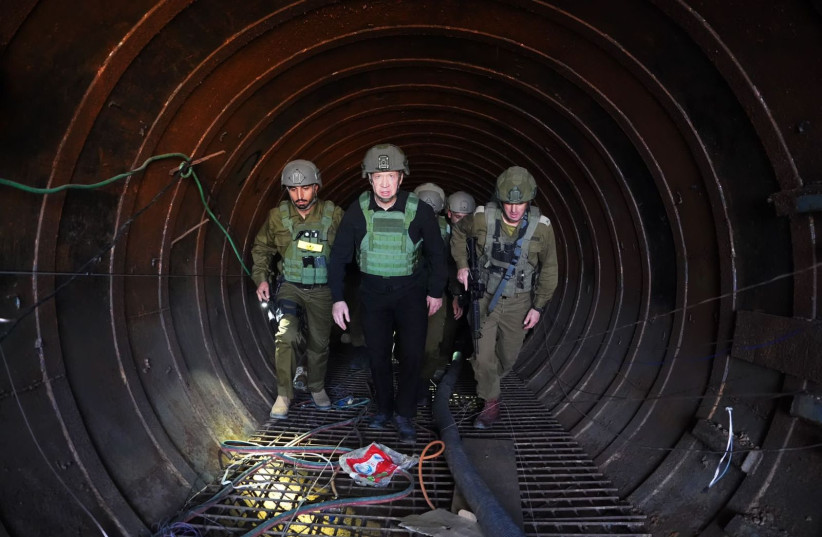Let’s start with how it is different.
This is the first conflict since Hamas took over Gaza in 2007, in which the IDF invaded for real.
There was a sort of invasion-lite of the outskirts of northern Gaza in 2014, and there was a somewhat more serious incursion of Gaza in 2008-2009.
But in 2014, the IDF barely entered any critical areas, keeping most ground troops on the edge of urban areas, and mostly depended on airstrikes, tank, and artillery fire.
Though 2008-2009 was more serious, the actual ground invasion part of the war lasted only about two weeks, far from the amount of time needed to substantially harm Hamas long-term, let alone topple the terrorist group.
In 2012 and 2021, the IDF almost entirely relied on air power, and in numerous other exchanges with Gaza since 2007, relied entirely on airpower.
In most earlier rounds, the IDF did not call up all the reserves, or but some tens of thousands soldiers, with most doing very little.
In contrast, this time the IDF called up 360,000 reservists, large numbers of whom served in invasions deep into the heart of Gaza’s most dangerous cities.
This time, the IDF has already taken operational control over Gaza City, Jabalia, Shejaia, and most other areas of northern Gaza around two weeks ago (Daraj – Tuffah remains unconquered, but is expected to be finished soon). Also, this time the IDF is deep into the heart of Khan Younis, Gaza’s second-largest city.
Next, if in the past the IDF neutralized some tunnel shafts, this time it is spending extensive time and munitions to completely destroy tunnels which it discovers.
If in 2008-2009, fewer than 1,500 Palestinians were killed and in 2014 around 2,100 (about half of whom were fighters), this time the IDF is probably close to having killed 9,000 Hamas terrorists, plus wounding thousands, and arresting reportedly well over 1,000.
Whereas in past rounds, the IDF celebrated killing any small number of Hamas commanders, this time the IDF has killed likely over half of its key commanders, and a significant majority of its naval commanders.
In addition, the IDF has reduced Hamas’s capacity to fire rockets on Israel to the lowest level since the terrorist group gained the capability to fire rockets on Tel Aviv and central Israel.
The IDF also took over the all-important Hamas command center and symbol of Shifa Hospital.
The sum total of these accomplishments and ongoing pressure by the IDF on what is left of Hamas’s forces and on its top leadership, also led to the organization freeing 81 hostages, and seriously considering another hostage release deal.
So far, the IDF and the country are also far more committed, with the war about to cross the three-month point and a clear commitment to be ready to fight a Hamas low-intensity insurgency in the near future.
Those are all the ways that this war is different.
How is this conflict the same to previous ones?
Unfortunately, so far, there are some critical ways that this conflict is similar to the others.
Until the IDF kills Hamas’s top leadership or returns the remaining 130 hostages, or both, it will not have attained the goals set for the war.
Not only that, but if in past conflicts the IDF said that terms like “victory” and “decisive” should be tossed out of the lexicon as outdated, this time the IDF and the government said they would demand toppling Hamas and total victory.
With all of Hamas’s top three leaders in Gaza still free (despite an impressive operation eliminating Hamas’s deputy chief outside of Gaza, Saleh al-Aruri), and with around 50% of their fighters still walking the streets or Gaza tunnels, top defense officials say it could take months more before achieving a decisive victory.
Rocket fire may be down, but it is nowhere near gone. Hamas reminded Israel of that fact with a barrage of 30 rockets into central Israel right as the new year of 2024 began.
Israel has barely touched Rafah, and until it has operational control there, there is no way to completely end rocket fire.
When Israel says it expects a three-to-nine-month insurgency even after the “main war” is over, another way of saying that is that if the country runs out of steam for fighting somewhere in the middle of that marathon, Hamas may be able to reconstitute itself despite all the punishment it has absorbed.
And if Israel cannot figure out some party, and a competent one, to hand over control of Gaza to when it will inevitably eventually need to withdraw IDF forces, Hamas may have yet another window to return.
All of this means that while the current war to date is radically different from any of the prior Gaza wars, until Israel notches some additional key achievements and shows it is willing to go the distance, the end result could remain the same.
How is Israel's war on Hamas different than others wars in Gaza?
This is the first conflict since Hamas took over Gaza in 2007, in which the IDF invaded for real.

